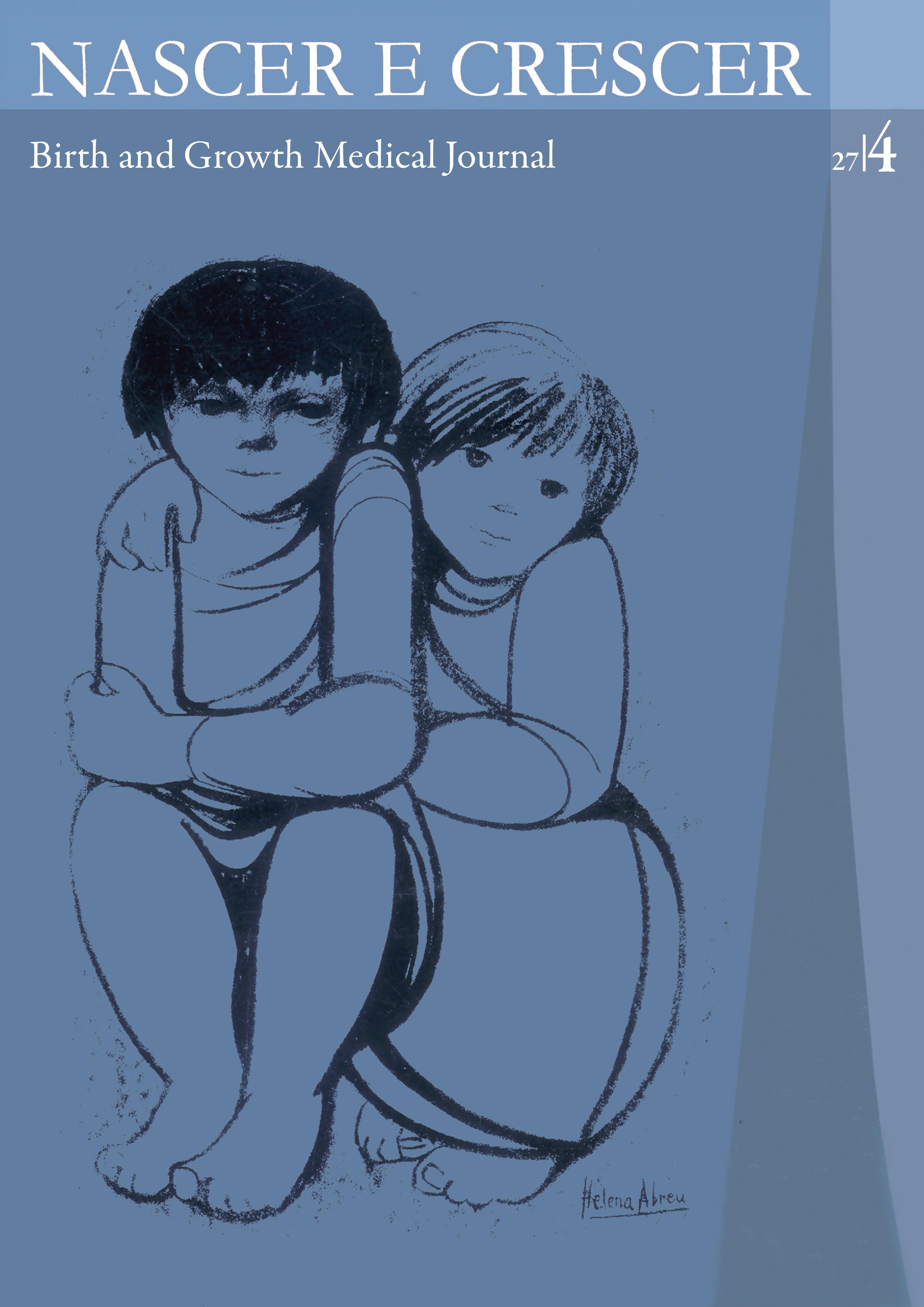Administração de soros - Que direção?
DOI:
https://doi.org/10.25753/BirthGrowthMJ.v27.i4.13698Palavras-chave:
Acidose metabólica, Equilíbrio ácido-base, Equilíbrio hidro-eletrolítico, Hipercloremia, Hiponatremia, SoroResumo
Introdução: A utilização de soros para hidratação endovenosa é uma prática comum em idade pediátrica, não sendo isenta de riscos.
Métodos: Este foi um estudo de coorte retrospetivo que incluiu todas as crianças admitidas para recobro cirúrgico com necessidade de hidratação endovenosa numa Unidade de Cuidados Intensivos Pediátricos, entre janeiro e dezembro de 2015. Foram registados os valores de sódio, cloro e excesso de bases em dois períodos: após a cirurgia e durante o internamento na Unidade.
Resultados: Foram incluídas 207 crianças, 66% das quais do sexo masculino, com idade mediana de 6,7 anos. Os soros utilizados foram soro fisiológico, NaCl 0,45% com 5% de dextrose e polieletrolítico. Os soros mais frequentemente utilizados foram polieletrolítico (62%) e soro fisiológico (48%) no bloco operatório e soro fisiológico (63%) e NaCl 0,45% (44%) na Unidade de Cuidados Intensivos Pediátricos. No bloco operatório, a utilização de soro fisiológico traduziu-se em valores medianos de cloro mais elevados e valores de excesso de bases (acidose metabólica) mais negativos do que os observados com soro polieletrolítico. Na Unidade de Cuidados Intensivos Pediátricos, a administração de soro fisiológico conduziu a hipercloremia (p=0,002) e acidose metabólica mais pronunciada (p=0,019) do que o observado com NaCl 0,45%. Não foi observada uma associação estatisticamente significativa entre o tipo de soro utilizado e os valores de sódio registados.
Discussão: Este estudo demonstra que a utilização de soro fisiológico se associa ao desenvolvimento de acidose hiperclorémica. Tal sugere que a substituição de soro fisiológico por um soro com valores de eletrólitos semelhantes ao plasma poderá ter benefícios para o doente.
Downloads
Referências
Orbegozo Cortés D, Rayo Bonor A, Vincent JL. Isotonic crystalloid solutions: A structured review of the literature. Br J Anaesth. 2014; 112:968–81.
Intravenous fluid therapy in children and young people in hospital. Nice Guidelines (2016).
Holliday MA, Ray PE, Friedman AL. Fluid therapy for children: facts, fashions and questions. Arch Dis Child. 2007; 92:546–50.
Guidet B, Soni N, Rocca G, Kozek S, Vallet B, Annane D, et al. A balanced view of balanced solutions. Critical Care. 2010; 14:325.
Moritz ML, Ayus JC. Hospital-acquired hyponatremia-why are hypotonic parenteral fluids still being used? Nat Clin Pract Nephrol. 2007; 3:374–82.
Oh GJ, Sutherland SM. Perioperative fluid management and postoperative hyponatremia in children. Pediatr Nephrol. 2016; 31:53–60.
Mcnab S, Duke T, South M, Babl FE, Lee KJ, Arnup SJ, et al. 140mmol/L of sodium versus 77 mmol/L of sodium in maintenance intravenous fluid therapy for children in hospital (PIMS): a randomised controlled double-blind trial. 2014; 6736:1–8.
Holliday MA, Segar WE. The maintenance need for water in parenteral fluid therapy. Pediatrics. 1957; 19:823-32.
Friedman JN. Risk of acute hyponatremia in hospitalized children and youth receiving. Paediatr Child Health. 2013; 18:102–4.
Hoorn EJ, Geary D, Robb M, Halperin ML, Bohn D. Acute hyponatremia related to intravenous fluid administration in hospitalized children: an observational study. Pediatrics. 2004; 113:1279–84.
Wang J, Xu E, Xiao Y. Isotonic Versus Hypotonic Maintenance IV Fluids in Hospitalized Children: A Meta-Analysis. Pediatrics. 2014; 133:105–13.
Cavari Y, Pitfield AF, Kissoon N. Intravenous Maintenance Fluids Revisited. Pediatr Emerg Care. 2013; 29:1225–8.
Lobo DN, Awad S. Should chloride-rich crystalloids remain the mainstay of fluid resuscitation to prevent “pre-renal” acute kidney injury? Kidney Int. 2014; 86:1096–105.
Taylor D, Durward A. What routine intravenous maintenance fluids should be used? Arch Dis Child. 2004; 89:411–8.
Choong K, Arora S, Cheng J, Farrokhyar F, Reddy D, Thabane L, et al. Hypotonic Versus Isotonic Maintenance Fluids After Surgery for Children: A Randomized Controlled Trial. Pediatrics. 2011; 128:857–66.
Coulthard MG, Long DA, Ullman AJ, Ware RS. A randomised controlled trial of Hartmann’s solution versus half normal saline in postoperative paediatric spinal instrumentation and craniotomy patients. Arch Dis Child. 2012; 97:491–6.
Krajewski ML, Raghunathan K, Paluszkiewicz SM, Schermer CR, Shaw AD. Meta-analysis of high-versus low-chloride content in perioperative and critical care fluid resuscitation. Br J Surg. 2015; 102:24–36.
McFarlane C, Lee A. A comparison of Plasmalyte 148 and 0.9% saline for intra-operative fluid replacement. Anaesthesia. 1994; 49:779–81.
Young JB, Utter GH, Schermer CR, Galante JM, Phan HH, Yang Y, et al. Saline versus Plasma-Lyte A in initial resuscitation of trauma patients: a randomized trial. Ann Surg. 2014; 259:255–62.
Jagt VD. Fluid management of the neurological patient: a concise review. Critical Care. 2016; 20:126. doi:10.1186/s13054-016-1309-2.
Handy JM, Soni N. Physiological effects of hyperchloraemia and acidosis. Br J Anaesth. 2008; 101:141–50.
Magder S. Balanced versus unbalanced salt solutions: What difference does it make? Best Pract Res Clin Anaesthesiol. 2014; 28:235–47.
Waters JH, Gottlieb A, Schoenwald P, Popovich MJ, Sprung J, Nelson DR. Normal saline versus lactated Ringer’s solution for intraoperative fluid management in patients undergoing abdominal aortic aneurysm repair: an outcome study. Anesth Analg [Internet]. 2001; 93:817–22.
Yunos NM, Bellomo R, Hegarty C, Story D, Ho L, Bailey M. Association between a chloride-liberal vs chloride-restrictive intravenous fluid administration strategy and kidney injury in critically ill adults. Jama. 2012; 308:1566–72.
Todd SR, Malinoski D, Muller PJ, Schreiber MA. Lactated Ringer’s is Superior to Normal Saline in the Resuscitation of Uncontrolled Hemorrhagic Shock. 2007; 62:636-9.
Ahn HJ, Yang M, Gwak MS, Koo MS, Bang SR, Kim GS, et al. Coagulation and biochemical effects of balanced saltbased high molecular weight vs saline-based low molecular weight hydroxyethyl starch solutions during the anhepatic period of liver transplantation. 2008; 63:235–42.
McNab S, Ware RS, Neville KA, Choong K, Coulthard MG, Duke T, et al. Isotonic versus hypotonic solutions for maintenance intravenous fluid administration in children. Cochrane Database Syst Rev. 2014:CD009457. doi:10.1002/14651858.CD009457.pub2.
Downloads
Publicado
Como Citar
Edição
Secção
Licença
Copyright and access
This journal offers immediate free access to its content, following the principle that providing free scientific knowledge to the public provides greater global democratization of knowledge.
The works are licensed under a Creative Commons Attribution Non-commercial 4.0 International license.
Nascer e Crescer – Birth and Growth Medical Journal do not charge any submission or processing fee to the articles submitted.


